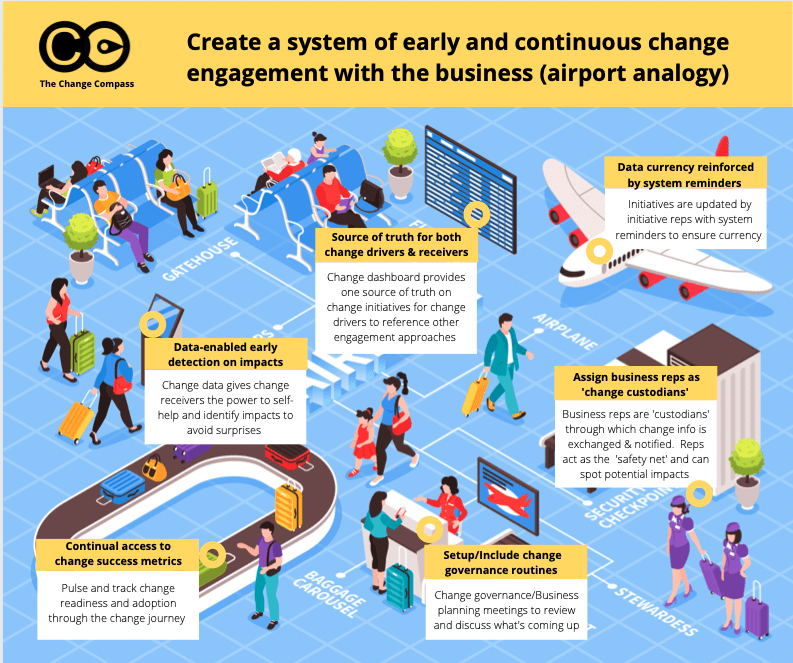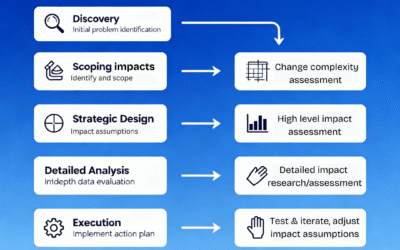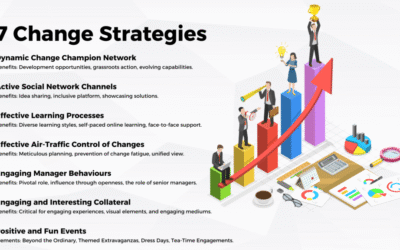Change is akin to navigating through the skies; it requires careful planning, clear communication, and the ability to adapt to shifting conditions. In the same way that a well-orchestrated airport ensures the safe and efficient movement of passengers and cargo, organizations must design a robust system for change management to achieve success in today’s dynamic business environment. As we explore the intricacies of designing such a system, we’ll draw parallels to the meticulous planning and execution required in airport operations.
Data Currency: Reinforced by System Reminders
Imagine an airport where flight schedules are constantly updated to reflect changes in departure times, gate assignments, and weather conditions. Similarly, our change management system employs reminders to ensure that change initiatives are regularly updated by initiative representatives. This emphasis on data currency mirrors the real-time updates necessary for smooth operations in an airport, enhancing agility and equipping stakeholders with the latest insights to drive informed decision-making.
Source of Truth for Both Change Drivers & Receivers
Just as an air traffic control tower serves as the central hub for coordinating flight information, our change dashboard serves as a centralized source of truth for all stakeholders. This dashboard provides change drivers and receivers with comprehensive insights into ongoing initiatives, fostering transparency and alignment across the organization. Much like how clear communication among air traffic controllers, pilots, and ground staff is essential to avoid chaos in an airport, our centralized repository facilitates collaboration and empowers stakeholders to navigate the change journey with confidence.
Data-Enabled Early Detection on Impacts
Modern aircraft are equipped with advanced sensors to detect potential issues early and prevent disruptions during flights. Similarly, our change management system leverages data to anticipate and mitigate impacts before they escalate. By providing stakeholders with the tools to self-assess and identify potential disruptions, surprises are minimized, and proactive measures can be taken to ensure a seamless transition. This proactive approach mirrors the preventive measures taken in aviation to maintain safety and efficiency in flight operations.
Assigning Business Reps as “Change Custodians”
In an airport, ground staff play a crucial role in ensuring the smooth flow of operations and addressing potential issues as they arise. Similarly, designating business representatives as change custodians facilitates the exchange of critical information and ensures that potential impacts are identified and addressed in a timely manner. By acting as the frontline support for change initiatives, these representatives serve as the linchpin of change maturity, fostering a culture of accountability and ownership throughout the organization.
Continual Access to Change Success Metrics
Much like pilots rely on instruments to gauge their progress and make informed decisions during flights, stakeholders require access to real-time metrics to assess change readiness and adoption. Pulse checks and regular tracking throughout the change journey provide stakeholders with the insights needed to course-correct and adapt as necessary. Additionally, change governance routines, akin to strategic planning meetings in aviation, provide a forum for reviewing upcoming changes and fostering alignment with organizational goals.
Designing a system for change maturity requires careful planning, clear communication, and a commitment to continuous improvement, much like orchestrating the intricate operations of an airport. By embracing the airport analogy and drawing inspiration from its principles, organizations can navigate the complexities of change with confidence and achieve sustainable success in today’s ever-evolving business landscape.
Please click the below to download the infographic.
DOWNLOAD.






